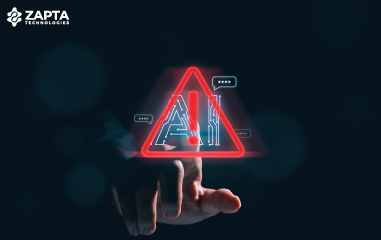Tired of Writing the Same Code Over and Over? Generative AI Just Handed You a Shortcut.
Let’s face it. As developers, we spend way too much time on repetitive tasks. Wouldn’t it be great to automate the boring stuff so you can focus on what actually moves the needle?
Luckily, you’re living in an era dominated by Generative AI (think GPT, DALL-E, and Stable Diffusion). These tools are too good at things like generating code snippets, debugging, and even designing prototypes.
The Role of Generative AI in Accelerating Development and Creativity
But the problem is, even with all the hype around AI, most developers are barely scratching the surface of what it can do. You can do much more than basic text editing.
So, what else can Generative AI do for you in 2025 and beyond? Let’s find out.
Cutting-Edge Uses of Generative AI You Haven’t Tried Yet
You are well aware of how you can use generative AI for basic coding, such as code generation, debugging, etc. But why be basic when you can try endless possibilities? Here are some unconventional ways you can use these GEN AI tools to upgrade your game;
AI-powered Legacy Code Modernization
Imagine you have a program written in a language hardly anyone uses these days. We call this legacy code, which is still valuable but written in outdated programming languages like COBOL and Fortran. You can use Generative AI as a translator to rewrite the code into modern languages like Python, JavaScript, or Rust. The whole process is known as legacy code modernization, and it’s like giving your code a fresh new wardrobe.
Now, to do this, you simply have to feed the AI your legacy codebase. It can be a bunch of COBOL files that have been running your systems for decades. The AI analyses your code, understands its logic, and then rewrites it using a modern language of your choice. You can even ask the AI to refactor the code to make it more efficient or compatible with cloud-based systems.
Why it’s powerful?
Many organizations are stuck with outdated systems because modernizing them manually is a huge, time-consuming task. Generative AI automates this process, saving tons of time and reducing the risk of mistakes. Plus, it allows companies to keep their valuable systems running without being held back by outdated technology.
Bonus tip: You can use the same technique for cross-platform development (React Native to Flutter or IOS to Android)
Generative AI for Synthetic Data Creation
Sometimes, we need data to test, train, or simulate scenarios—but real data isn’t always available or safe to use. You can use Gen AI for synthetic data creation and generate artificial datasets that mimic real-world information. This data is perfect for testing applications, training machine learning models, or simulating edge cases.
It works by providing the AI with a schema or a sample of data you want to replicate. The AI will do its usual work of analyzing the structure and pattern and generating synthetic data. For example, if you’re working with customer data, the AI can create fake but realistic customer profiles, complete with names, addresses, and purchase histories.
The power of synthetic data lies in its versatility and safety. It’s incredibly useful for testing applications without risking exposure to sensitive information. You don't have to wait for real data to be collected or worry about privacy concerns and generate as much data as you desire anytime. This is especially valuable in industries like healthcare or finance, where data privacy regulations are strict.
AI-Powered Code Optimization
Simply writing code isn’t enough. You also have to ensure it's optimized for performance, memory usage, or energy efficiency. You can use Gen AI for this very purpose and fine tune your code to make it faster, leaner and more resource efficient.
Just provide AI your code and it will analyze it to identify areas for improvement and suggest optimizations like better algorithms, smarter memory management and opportunities for parallelization. For example, if your code has a loop that’s slowing things down, the AI might recommend a more efficient way to handle it or even rewrite that section entirely.
This powerful approach makes optimizing code much more accessible as every developer might not be an expert in performance tuning. This is especially useful for complex applications where even small optimizations can lead to significant improvements in speed or resource usage.
AI-Generated Unit Tests and Test Cases
Once you are done writing the main code for your application, it’s time to test it. But, writing unit tests and test cases can be both time-consuming and tedious. With Gen AI, you can give yourself a break and use it to create comprehensive tests, including edge cases you might not have thought of before.
Feed your code into your favourite AI tool, let it analyze its logic and structure . based on the analysis the AI generates unit tests and test cases covering a wide range of scenarios including edge cases. For example, if you have a function that handles user input, the AI might create tests to check how it behaves with unexpected or invalid inputs.
This way you can easily boost your testing coverage and catch bugs early on in the development cycle. Because, even the most experienced developers can miss edge cases but not AI. By automating test creation, it ensures your code is rigorously tested, reducing the risk of bugs making it into production. This is especially valuable for complex systems where manual testing can be overwhelming.
AI for Personalized Developer Learning
This one should be the best hack ever because being a developer there is always something new to learn. You have to figure out what you have to learn and how to learn by yourself which can be overwhelming. Now with Gen AI you can create custom learning paths tailored to your goals, skill gaps, interests and career goals. This way you grow as a developer with a focused learning approach without wasting time on irrelevant material.
For example, if you're struggling with advanced React concepts, AI can suggest specific tutorials or a mini project to help you master those skills. And the way to do it is to let AI know your current skills, coding style, projects and technologies and it’ll recommend tutorials, courses and hands-on projects as well. What you can do with Gen AI totally depends on your curiosity and creativity.
Having AI as your tutor, you can accelerate skill development and stay up to date with the latest technologies. Instead of sifting through endless resources or guessing what to learn next the AI acts as your personal coach that guides you on every step.
And that’s not all. The possibilities are endless. You can use AI to automate code reviews, for security and vulnerability detection, custom IDE and plugin generation, API custom software design and development company, and much more.
If Ai Is Going To Do All This, What Will I Do As A Developer?
After reading the above scenarios, you might be asking this. This answer to this is both reassuring and exciting:
You may think of AI as the ultimate productivity tool. Just as calculators didn’t make mathematicians obsolete but instead freed them to tackle more complex problems, AI is taking over the repetitive, time-consuming tasks that often bog down developers. Writing boilerplate code, debugging, and generating documentation are all tasks that AI can handle, allowing you to focus on what truly matters: solving hard problems, designing innovative systems, and creating impactful solutions.
The role of a developer is evolving, and that’s a good thing. Instead of being just coders, developers are becoming creators, architects, and innovators. With AI handling the groundwork, developers can spend more time on the fun stuff—optimizing performance, designing user-centric experiences, and exploring new frontiers in technology.
Moreover, AI is creating opportunities that didn’t exist before. Developers can now specialize in training and fine-tuning AI-Embedded Applications Development Company models, integrating AI into unique workflows, or even building the next generation of AI tools.
So, as we embrace this new era of Generative AI, let’s not fear the change but welcome it. The tools are getting better, the possibilities are expanding, and the role of a developer is becoming more creative, strategic, and impactful than ever before. The question isn’t “What will developers do?”—it’s “What can developers achieve with AI by their side?” The answer, as always, is limited only by our imagination.

















